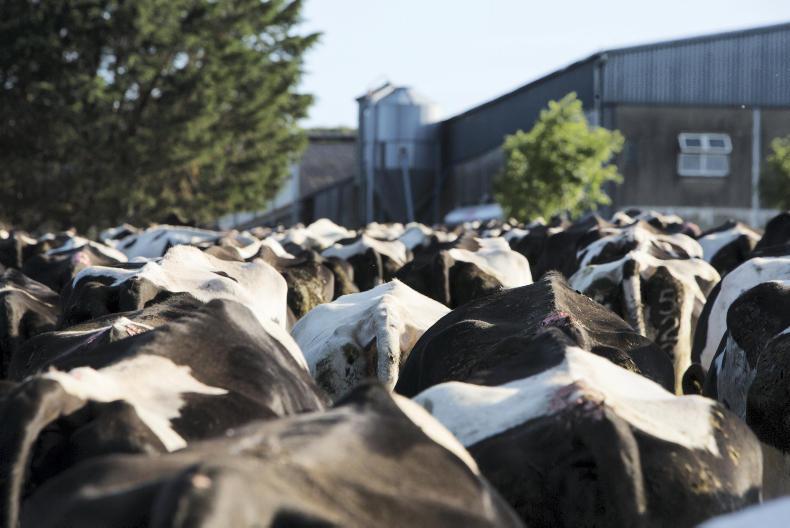Some 6,000 new entrants will be required by the dairy industry in the next 10 years, a report by Teagasc has found.
As dairy farmers prepared for milk production post-quota, cow numbers increased by 327,000 since 2010 to over 1.35m.

However, dairy farmer numbers have remained relatively static since 2010.
Now, with further expansion on the cards, a labour shortage is looming in the sector in the form of skilled new entrants.
The People in Dairy Project has found that as the dairy industry expands, there will be a greater requirement for highly skilled people.
Listen to "Gerry Boyle on the dairy labour shortage" on Spreaker.
Furthermore, Teagasc also expects that there will be a requirement for a much greater supply of seasonal labour to cope with the additional workload during calving and breeding.
From now until 2025 it is estimated that there will be a requirement at farm level for an additional 2,315 full-time equivalents (FTEs) and 3,958 replacement FTEs to sustain regeneration to facilitate a sustainable expansion of the Irish dairy industry.
However, these estimates do not place any extra requirement for the substantial increase in the national dairy herd that has occurred over the last four years.
Given the projected requirements, the number of graduates qualifying at both Level 6 advanced programmes in dairy herd management and the Level 7 professional diploma in dairy farm management levels (approximately 120 and 25 graduates per year, respectively) are totally inadequate.
Solutions
One solution to the issue would be farmers in other farm enterprises working on dairy farms, Teagasc director Gerry Boyle has said.
“There is a big pool of labour on other farm enterprises, people with huge knowledge of livestock management and so on.
“Now, there is a reluctance for them it would seem to work on dairy farms, but I think that can be broken down.
“I think that maybe one initiative we could take is to organise a course that would show non-dairy
farmers the opportunities that could exist for supplementing their income by doing some work on dairy farms.”
The Farm Relief Service put forward a number of options to the Minister for Agriculture on the labour shortage problem earlier in the year and welcome the new report.
“We’re very conscious of the fact that there is a shortage and want to have it sorted on time for peak production next year,” said Peter Byrne from the Farm Relief Service.
Read more
What type of dairy workers are required in Ireland?
Foreign labour and intensive courses to help meet jobs demand
Farmer reactions to Teagasc report
The legalities around hiring foreign labour
Farmer Writes: dairy farming isn't all dirty elbows and 12-hour days
Editorial: long-term plan needed to solve labour shortage
Some 6,000 new entrants will be required by the dairy industry in the next 10 years, a report by Teagasc has found.
As dairy farmers prepared for milk production post-quota, cow numbers increased by 327,000 since 2010 to over 1.35m.

However, dairy farmer numbers have remained relatively static since 2010.
Now, with further expansion on the cards, a labour shortage is looming in the sector in the form of skilled new entrants.
The People in Dairy Project has found that as the dairy industry expands, there will be a greater requirement for highly skilled people.
Listen to "Gerry Boyle on the dairy labour shortage" on Spreaker.
Furthermore, Teagasc also expects that there will be a requirement for a much greater supply of seasonal labour to cope with the additional workload during calving and breeding.
From now until 2025 it is estimated that there will be a requirement at farm level for an additional 2,315 full-time equivalents (FTEs) and 3,958 replacement FTEs to sustain regeneration to facilitate a sustainable expansion of the Irish dairy industry.
However, these estimates do not place any extra requirement for the substantial increase in the national dairy herd that has occurred over the last four years.
Given the projected requirements, the number of graduates qualifying at both Level 6 advanced programmes in dairy herd management and the Level 7 professional diploma in dairy farm management levels (approximately 120 and 25 graduates per year, respectively) are totally inadequate.
Solutions
One solution to the issue would be farmers in other farm enterprises working on dairy farms, Teagasc director Gerry Boyle has said.
“There is a big pool of labour on other farm enterprises, people with huge knowledge of livestock management and so on.
“Now, there is a reluctance for them it would seem to work on dairy farms, but I think that can be broken down.
“I think that maybe one initiative we could take is to organise a course that would show non-dairy
farmers the opportunities that could exist for supplementing their income by doing some work on dairy farms.”
The Farm Relief Service put forward a number of options to the Minister for Agriculture on the labour shortage problem earlier in the year and welcome the new report.
“We’re very conscious of the fact that there is a shortage and want to have it sorted on time for peak production next year,” said Peter Byrne from the Farm Relief Service.
Read more
What type of dairy workers are required in Ireland?
Foreign labour and intensive courses to help meet jobs demand
Farmer reactions to Teagasc report
The legalities around hiring foreign labour
Farmer Writes: dairy farming isn't all dirty elbows and 12-hour days
Editorial: long-term plan needed to solve labour shortage







 This is a subscriber-only article
This is a subscriber-only article











SHARING OPTIONS: